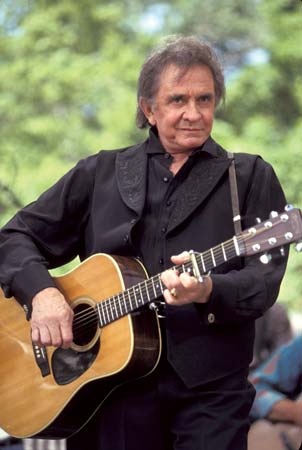country music
also called country and western
 style of 20th-century American (United States) popular music that originated among whites in rural areas of the South (South, the) and West (West, The). The term “country and western music” (later shortened to “country music”) was adopted by the recording industry in 1949 to replace the derogatory label “hillbilly music.”
style of 20th-century American (United States) popular music that originated among whites in rural areas of the South (South, the) and West (West, The). The term “country and western music” (later shortened to “country music”) was adopted by the recording industry in 1949 to replace the derogatory label “hillbilly music.”Ultimately, country music's roots lie in the ballads, folk songs, and popular songs of the English, Scots, and Irish settlers of the Appalachians and other parts of the South. In the early 1920s the traditional string-band music of the Southern mountain regions began to be commercially recorded, with Fiddlin' John Carson garnering the genre's first hit record in 1923. The vigour and realism of the rural songs, many lyrics of which were rather impersonal narratives of tragedies pointing to a stern, Calvinist moral, stood in marked contrast to the often mawkish sentimentality of much of the popular music of the day.
More important than recordings for the growth of country music was broadcast radio. Small radio stations appeared in the larger Southern and Midwestern cities in the 1920s, and many devoted part of their airtime to live or recorded music suited to white rural audiences. Two regular programs of great influence were the “National Barn Dance” from Chicago, Ill., begun in 1924, and the “Grand Ole Opry” from Nashville, Tenn., begun in 1925. The immediate popularity of such programs encouraged more recordings and the appearance of talented musicians from the hills at radio and record studios. Among these were the Carter Family and Jimmie Rodgers, whose performances strongly influenced later musicians. These early recordings were of ballads and country dance tunes and featured the fiddle and guitar as lead instruments over a rhythmic foundation of guitar or banjo. Other instruments occasionally used included Appalachian dulcimer, harmonica, and mandolin; vocals were done either by a single voice or in high close harmony.
With the migration of many Southern rural whites to industrial cities during the Great Depression and World War II, country music was carried into new areas and exposed to new influences, such as blues and gospel music. The nostalgic bias of country music, with its lyrics about grinding poverty, orphaned children, bereft lovers, and lonely workers far from home, held special appeal during a time of wide-scale population shifts.
 During the 1930s a number of “singing cowboy” film (motion picture) stars, of whom Gene Autry was the best known, took country music and with suitably altered lyrics made it into a synthetic and adventitious “western” music. A second and more substantive variant of country music arose in the 1930s in the Texas-Oklahoma region, where the music of rural whites was exposed to the swing jazz of black orchestras. In response, a Western swing style evolved in the hands of Bob Wills (Wills, Bob) and others and came to feature steel and amplified guitars and a strong dance rhythm. An even more important variant was honky-tonk, a country style that emerged in the 1940s with such figures as Ernest Tubb and Hank Williams (Williams, Hank). Honky-tonk's fiddle–steel-guitar combination and its bitter, maudlin lyrics about rural whites adrift in the big city were widely adopted by other country musicians.
During the 1930s a number of “singing cowboy” film (motion picture) stars, of whom Gene Autry was the best known, took country music and with suitably altered lyrics made it into a synthetic and adventitious “western” music. A second and more substantive variant of country music arose in the 1930s in the Texas-Oklahoma region, where the music of rural whites was exposed to the swing jazz of black orchestras. In response, a Western swing style evolved in the hands of Bob Wills (Wills, Bob) and others and came to feature steel and amplified guitars and a strong dance rhythm. An even more important variant was honky-tonk, a country style that emerged in the 1940s with such figures as Ernest Tubb and Hank Williams (Williams, Hank). Honky-tonk's fiddle–steel-guitar combination and its bitter, maudlin lyrics about rural whites adrift in the big city were widely adopted by other country musicians.The same period saw a concerted effort to recover some of country music's root values. Mandolin-player Bill Monroe (Monroe, Bill) and his string band, the Blue Grass Boys, discarded more recently adopted rhythms and instruments and brought back the lead fiddle and high harmony singing. His banjoist, Earl Scruggs (Scruggs, Earl), developed a brilliant three-finger picking style that brought the instrument into a lead position. Their music, with its driving, syncopated rhythms and instrumental virtuosity, took the name “ bluegrass” from Monroe's band.

 But commercialization proved a much stronger influence as country music became popular in all sections of the United States after World War II. In 1942 Roy Acuff (Acuff, Roy), one of the most important country singers, co-organized in Nashville the first publishing house for country music. Hank Williams' meteoric rise to fame in the late 1940s helped establish Nashville as the undisputed centre of country music, with large recording studios and the Grand Ole Opry as its chief performing venue. In the 1950s and '60s country music became a huge commercial enterprise, with such leading performers as Tex Ritter, Johnny Cash, Tammy Wynette, Buck Owens, Merle Haggard, Patsy Cline, Loretta Lynn, and Charley Pride. Popular singers often recorded songs in a Nashville style, while many country music recordings employed lush orchestral backgrounds.
But commercialization proved a much stronger influence as country music became popular in all sections of the United States after World War II. In 1942 Roy Acuff (Acuff, Roy), one of the most important country singers, co-organized in Nashville the first publishing house for country music. Hank Williams' meteoric rise to fame in the late 1940s helped establish Nashville as the undisputed centre of country music, with large recording studios and the Grand Ole Opry as its chief performing venue. In the 1950s and '60s country music became a huge commercial enterprise, with such leading performers as Tex Ritter, Johnny Cash, Tammy Wynette, Buck Owens, Merle Haggard, Patsy Cline, Loretta Lynn, and Charley Pride. Popular singers often recorded songs in a Nashville style, while many country music recordings employed lush orchestral backgrounds. The 1970s saw the growth of the “outlaw” music of prominent Nashville expatriates Willie Nelson and Waylon Jennings. The gap between country and the mainstream of pop music continued to narrow in that decade and the next as electric guitars replaced more traditional instruments and country music became more acceptable to a national urban audience. Country retained its vitality into the late 20th century with such diverse performers as Dolly Parton, Randy Travis, Garth Brooks, Reba McEntire, Emmylou Harris, and Lyle Lovett. Despite its embrace of other popular styles, country music retained an unmistakable character as one of the few truly indigenous American musical styles.
The 1970s saw the growth of the “outlaw” music of prominent Nashville expatriates Willie Nelson and Waylon Jennings. The gap between country and the mainstream of pop music continued to narrow in that decade and the next as electric guitars replaced more traditional instruments and country music became more acceptable to a national urban audience. Country retained its vitality into the late 20th century with such diverse performers as Dolly Parton, Randy Travis, Garth Brooks, Reba McEntire, Emmylou Harris, and Lyle Lovett. Despite its embrace of other popular styles, country music retained an unmistakable character as one of the few truly indigenous American musical styles.- Frescobaldi Family
- Frescobaldi, Girolamo
- fresco painting
- Fresenius, Carl Remigius
- Freshfield, Douglas William
- Freshwater
- freshwater jellyfish
- freshwater snail
- freshwater sponge
- Fresnay, Pierre
- Fresnel, Augustin-Jean
- Fresnel lens
- Fresnes
- Fresnillo
- Fresno
- fret
- Freud, Anna
- Freudenstadt
- Freudenthal, Axel Olof
- Freudian criticism
- Freud, Lucian
- Freud, Sigmund
- Frey, Adolf
- Freya Stark
- Freyberg, Bernard Cyril Freyberg, 1st Baron